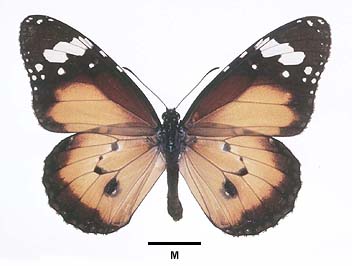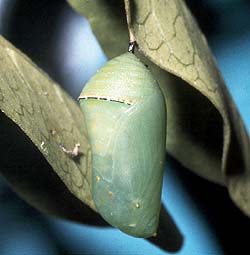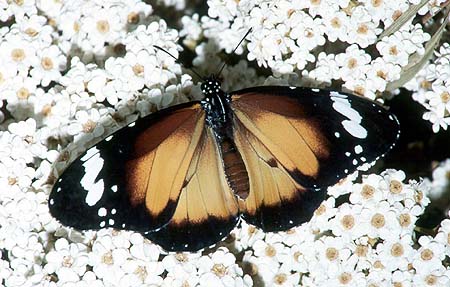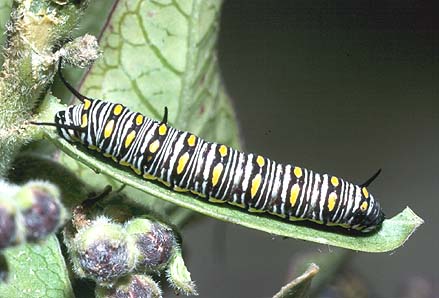-
Larval Food Host
-
*Asclepias curassavica (red-head cotton-bush),
*Gomphocarpus (Asclepias) fruticosus (swan plant),
*G. physocarpus (balloon cotton-bush),
*G. cancellatus (rotundifolia) (broad-leaved cotton-bush),
*Calotropis spp incl. *C. procera (king's crown),
Cynanchum species including C. floribundum (desert cynanchum or native pear),
Marsdenia (Leichhardtia) australis (native pear),
Rhyncharrhena (Pentatropis) linearis (bush bean or cotton vine),
*Orbea (Stapelia) variegata (carrion flower),
Sarcostemma spp (Asclepiadaceae).
The toxicity of each plant species varies. The poisonous properties of the introduced milk-weeds
from Africa and the Americas are cardiac glycosides (cardenolide heart poisons). The poisonous
properties of native milkweeds are not well known, but appear to be different to the introduced
species. Marsdenia poisons include alkaloids, while Sarcostemma poisons include
saponic and steroidal glycosides. The larvae prefer to eat the leaves of the hostplant, but if
the larvae are numerous they will eat all the softer parts of the plant, including flowers
and the immature fruiting capsules. Around Adelaide, Gomphocarpus cancellatus and
G. fruticosus are the main hostplants, and it is usually the former which is preferred,
and the first to be attacked if both plants are growing together.
-
Eggs
-
Initially pale yellow, later becoming white.
Subconical elongate, about one and a half times as high as wide, bluntly pointed apically,
flattened basally, finely ribbed vertically with about 20-22 ribs, and with numerous
indistinct lateral ridges. The egg pits are rectangular shaped. Laid singly,
usually on the undersides of the hostplant leaves, but sometimes on other softer parts of
the plant. The eggs hatch in about 5 days. The larvae eat the egg shell before
proceeding to eat other parts of the hostplant. In the southern temperate areas the
females usually visit the hostplants in a transitory mode, laying eggs and then moving on.
-
Larvae
-
Initially brownish grey-white, with a few short black hairs that are more common posteriorly.
A pair of black patches occur behind the head on the prothoracic plate, and another black patch
occurs dorsally at the posterior end on the anal plate. The head is black and shining with
a few short black hairs. A pair of brown fleshy protuberances occur behind the prothoracic plate,
and again about a third the way from the head (second abdominal segment), and at the posterior end.
After eating the hostplant, the larva turns pale greyish white and acquires ten dorsal transverse
black bands with paired large yellow spots. Subsequent instars acquire the typical bright warning
colours of white, yellow and black to the body and head. The fleshy protuberances become progressively
longer with each instar, developing into flexible fleshy black spines or filaments.
Initially the larvae feed by scouring the leaf surface, avoiding the major veins as
puncturing the latter would cause a flow of the milky-white sticky sap, which may engulf
the larva and disable it. Older larvae will eat the entire leaf and if hungry
enough, also other soft parts of the hostplant. They feed openly during the day,
with their bright warning colours affording them protection against bird predators.
When strongly handled or attacked, the larva will regurgitate a fluid which is much more
poisonous than the rest of its body. The larva will swing its head about in an
attempt to spread the poisonous regurgitant onto the predator. Like many other
butterfly species, the older heavier larvae silk the leaf to the stem in case the leaf
should accidentally detach with them still upon it.
The final instar is about 38 mm long, essentially smooth, but with a few very small
spinose secondary setae. Black beneath, mostly white above with ten broad black
transverse dorsal bands which are constricted laterally, and which contain a dorsal pair
of large transversely elongated yellow spots. These bands are separated by three
finer bands of black, which are discontinuous laterally. The lateral white areas are
daubed with yellow, and there are additional large white spots sublaterally and on the
sides of most of the legs. There is a long pair of flexible, black, slightly
bristly, fleshy tentacular spines or sensory filaments behind the prothoracic plate, and
there are further shorter pairs on the second abdominal segment and at the posterior end.
The basal part of the filaments is sometimes coloured bright red. The head is
smooth, rounded, black, edged white, with a few short black hairs, and there is a white
inverted frontal V mark with a further white triangular shaped spot inside the V, and the
mouth is white. The larval duration is about 18 days.
The larvae of the Lesser Wanderer are quickly differentiated from the larvae of the
Wanderer by the presence of three pairs of tentacular filaments, rather than two pairs in
the Wanderer.
-
Pupae
-
Large, stout, mostly smooth, about 20 mm long (including the cremaster), the posterior
end is rounded and slightly rugose, and ends in a short black cremaster. Rounded anteriorly,
but with a pair of apical protuberances, the wing bases are slightly protuberant,
and there is a finely beaded slightly raised transverse ridge dorsally on the abdomen.
Polymorphic coloured, either pale green, bluish-green, pink or yellowish-brown.
After pupation there is a series of paired dorsal yellow marks, and the abdomen is
marked yellow laterally, but these yellow marks are lost after a couple of days.
There are also five pairs of shining golden spots, on the thorax (two pairs),
at the wing bases, on the anterior protuberances, and ventrally. The transverse dorsal
abdominal ridge is outlined in gold, edged black anteriorly. There is a long, black,
inverted V shaped mark emanating abdominally from the cremaster.
The mature larvae usually leave the hostplant to pupate, sometimes travelling a great
distance before stopping. This trait is probably a necessity as later larvae may
completely denude the hostplant of the leaves necessary for pupal camouflage, or at worst
may snip off the pupal attachment causing the pupa to fall to the ground to be subject to
predation or cooking on the hot exposed earth. During this exodus larvae may be
predated upon by ants, the contained toxins within the larvae apparently having no undue
effect upon the ants. However the larvae are not attacked by the same ants while the
larvae are feeding on the hostplant. Those larvae which remain on the hostplant to
pupate are often diseased or parasitized.
The pupa is suspended head downwards by the cremaster, usually in a leafy situation
which provides camouflage. The pupal stage lasts about 15 days. If the pupation medium
is a potentially deciduous leaf, then the larva will make sure the leaf remains secure
for the duration of the pupal period by spinning silk between the base of the leaf
and the stem. The pupal colour is not necessarily camouflage dependent, as pink pupae
can also occur in green leafy environments. The usual pupae colour around Adelaide
is pale green, and both green and pink types can occur together. In other parts of
the world the pink pupae can be dominant.
-
Flight Period in South Australia
-
It is possible to find flying butterflies throughout the year in the Far North.
In the temperate south of the state, the butterfly is more transitory, and can
be seen at various times during the warmer months depending on whether the
butterfly is an immigrant or occurs in a semi-established population. It is
usually more common in the south during late summer and autumn.
During the southern winter months, it can occasionally be seen with overwintering
populations of the Wanderer in the frost free maritime coastal areas. These
butterflies, similar to the Wanderer, presumably have large fat reserves. Early
stage development ceases below about 12 degrees C. The brood period is highly
temperature dependent, being 4-6 weeks during the warmer months in the temperate south.

-
Distribution
-
The butterfly is a vagrant and can occur throughout Australia, including
Kangaroo Island and Tasmania. It sometimes occurs at great distances from
its hostplant. It hasan extensive distribution outside of Australia that
includes much of the hotter parts of the eastern Hemisphere, and occurs as
various subspecies and forms.
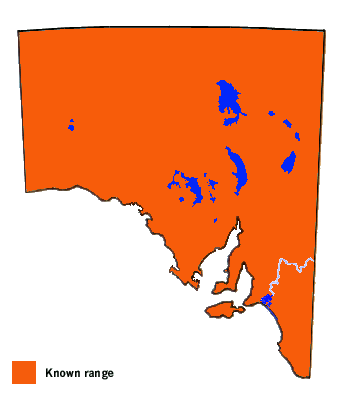
-
Habitat
-
The hostplants occur in a wide variety of habitats. Its native hostplants occur
in northern pastoral areas. The introduced milkweed hostplants have allowed
the butterfly to breed in the southern settled areas.
-
Conservation Status in South Australia
-
A vagrant, sometimes locally common in breeding areas.
-
Threats
-
No major threats.
-
Conservation Strategy
-
None required.
